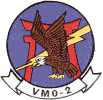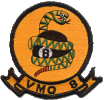USMC Helicopter/Tiltrotor Squadrons
Squadron Pages
Marine Observation Groups
Squadrons
A Short History of Marine Observation Squadrons
1922-43
The first Marine Observation Squadrons were formed in 1922. Although designated "Observation" squadrons, they were mainly used for scouting and close-air support for the Marine Expeditionary Brigades in Haiti, Nicaragua, and China. On July 27 1927, Marine Observation Squadron 7 (VO-7M) made the first organized dive-bombing attack in history, routing a bandit force surrounding a Marine garrison at Ocotal, Nicaragua. Six months later, Lt Christian F. Schilt, from VO-7M, earned the Medal of Honor when he flew into Quilahi, Nicaragua, under fire, to rescue wounded Marines. In the course of three days, Schilt made ten round-trips, bringing in over 1,400 lbs of supplies, and flying out 18 seriously wounded Marines.
The 1930s saw a reduction in Marine aviation units and the five Observation squadrons were either deactivated or consolidated. In July 1937, all Marine Corps squadrons were reorganized and the three surviving Observation squadrons became Scouting squadrons. One observation squadron, VMO-1, was formed in 1941, redesignating as VMO-151 in July. Though it carried the "Observation" designation it was really a Scout-Bombing squadron.
For the first two years of WW2, there were three "Observation" squadrons - VMOs 151, 251, 351. A fourth, VMO-951, was formed in 1944, but deactivated after less than a month. These units were equipped with fighters and were used primarily as photographic squadrons. All became fighter or dive-bomber squadrons by 1943.
1943-49
In December 1943 the first of eight true observation squadrons was formed. Each Marine Division would have a squadron assigned to it to provide spotting for the artillery. The VMOs could also carry messages, scout enemy positions, evacuate wounded, and perform search and rescue of downed pilots. Seven of the eight VMOs saw combat during the war; VMO-3 was awarded a well-deserved Presidential Unit Citation for its service at Okinawa. Following the war, VMO-2 and -5 performed occupation duty in Japan; VMO-3 and -6 operated in Northern China until 1946; VMO-1 relocated to Cherry Point. At the end of 1949 only VMO-1 at Cherry Point and VMO-6 at Camp Pendleton were in service.
1950-68
1950 saw the introduction of helicopters to the VMOs. VMOs-1
and -6 operated a mix of Sikorsky HO3S, HO5S, Bell HTL, and Kaman
HOK helicopters, as well as the new Cessna OE "Bird Dog"
observation planes. In 1950, VMO-6 was ordered to deploy to Korea
for combat duty. 4 Sikorsky HO3S light observation helicopters,
along with pilots and maintenance personnel from HMX-1 were
attached to the squadron. VMO-1 remained on the East Coast, and
VMO-2 was reactivated on the West Coast. All operated a mix of
helicopters and fixed-wing aircraft.
In 1964, VMO-1 became the first squadron to operate the
turbine-powered UH-1E. The "Huey" would be a mainstay of VMO
squadrons for the next 10 years. In 1965, VMO-2 and VMO-6 both
deployed to South Vietnam. Except for a short period when VMO-2
and VMO-6 operated a small O-1 "Bird Dog" detachment, the VMOs
were helicopter squadrons. They initially performed gunfire
spotting missions, as well as liason and medevacs. Soon, with the
addition of the TK-2 weapons kit (1 M60 machinegun and a 7 or 19
shot rocket pod mounted on either side of the aircraft) they
became gunships. The TAT-101 (2 M60s in a chin turret) was later
added. The three VMOs in Vietnam (VMO-3 was activated and
deployed in 1966) served with distinction throughout their time
in country. In 1967 Captain (later Major) Steven Pless, a gunship
pilot with VMO-6, was awarded the Medal of Honor for his daring
rescue of American troops.
1968-94
In 1968, the OV-10 joined the VMOs and the decision was made
that VMO-1,2,and 6 would revert to fixed-wing squadrons. VMO-3
& VMO-5 (Camp Pendleton) retained their UH-1Es and became
HMLs. Reserve squadron VMO-4 traded in its UH-34Ds for OV-10s;
VMO-8 was reactivated at El Toro and equipped with the "Bronco".
VMO-1 and VMO-6 briefly operated the AH-1J "Sea Cobra" (as
training units), but after 1972 were completely fixed-wing units,
ending the VMO use of helicopters.
In 1969 VMO-6 relocated to Okinawa, where it operated in support
of the 3d Marine Division until deactivating in 1976. VMO-2 left
Vietnam in 1971 and was based at Camp Pendleton until 1992. VMO-2
and VMO-1 rotated aircraft and personnel to Okinawa on a regular
basis. In 1976, VMO-4 relocated to Atlanta, GA and VMO-8 was
deactivated.
In 1990, VMO-1 and VMO-2 were deployed to Kuwait for Operation
"Desert Shield/Storm". Each squadron lost an aircraft to enemy
fire; three crewmen were captured, one was killed in action. This
was the last hurrah for the VMOs. First VMO-2, and then VMO-1
were deactivated, leaving Reserve VMO-4 as the last of the VMOs.
On 31 March 1994, VMO-4, the last VMO left in the Marine Corps
was deactivated.






